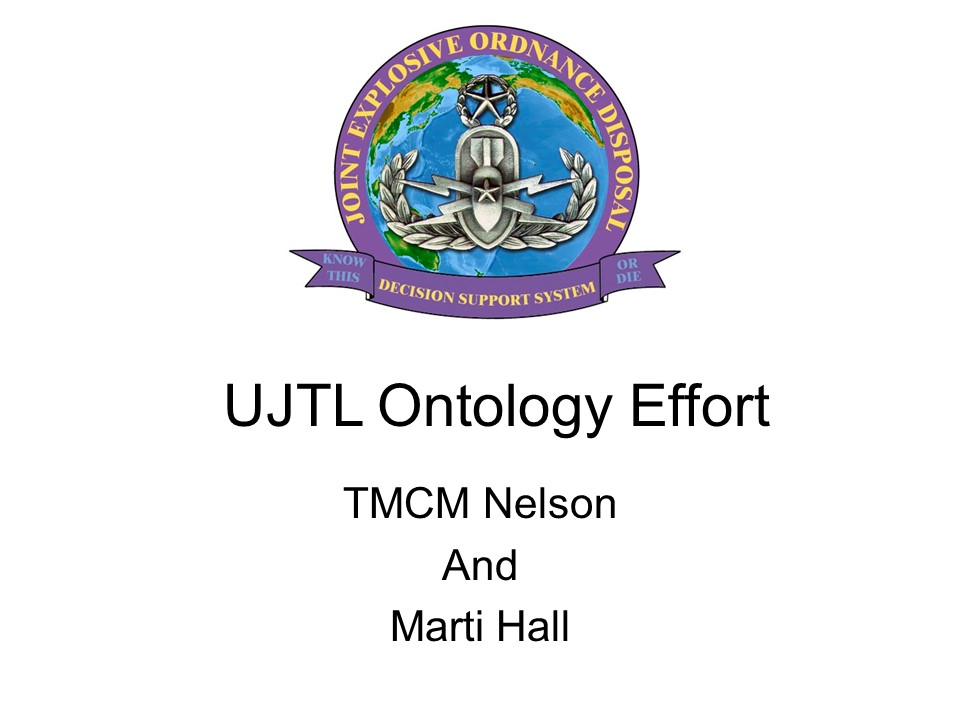UJTL Ontology Effort - PowerPoint PPT Presentation
Title:
UJTL Ontology Effort
Description:
Who and How the task will be performed are determined by ... Choke points are defined. Intelligence has mines in the SLOC and in valley leading to objective ... – PowerPoint PPT presentation
Number of Views:86
Avg rating:3.0/5.0
Title: UJTL Ontology Effort
1
UJTL Ontology Effort
- TMCM Nelson
- And
- Marti Hall
2
Overview
- Vision for the UJTL and METLs
- Scenario
- Mapping
- Findings
- Proposed POAM outline
3
Universal Joint Task List
- Provides a common language - required by law
- NCA, CINC, JTF, to the Warfighter
- Who and How the task will be performed are
determined by Conditions/Measures, Doctrine, and
CONOPS - Uses Readiness, Training, Acquisition, C4ISR
(IER) - Future Doctrine and TTP without boundaries,
mission planning, PMA, and resource analysis
4
(No Transcript)
5
Task and Scenario
- Use Land Mine Warfare as test case for UJTL DAML
solution to doctrine and TTP - Scenario
- NCA objective is to retake oil fields from
invading force - CINC objective is to marshal forces, prepare, and
strike - Select Forces
- Obstacles to Maneuver
6
Scenario
- JTF Commander and Component Commanders determine
COAs - Choke points are defined
- Intelligence has mines in the SLOC and in valley
leading to objective - Mission is to land forces on hostile shore,
maneuver and take objective - Use of Mine Countermeasure Forces and tactics is
needed
7
Scenario
- Tactical level
- What tasks must be preformed to accomplish higher
level tasks - Tri-service effort (described in mission flow)
- Used Army and Navy/MC EOD as the tactical example
- Various assets involved
8
The Mapping Effort
9
(No Transcript)
10
(No Transcript)
11
(No Transcript)
12
(No Transcript)
13
(No Transcript)
14
(No Transcript)
15
Standardization Create once use many times
16
EOD DSS Demonstration
As we move more towards multi-mission platforms,
awareness of how these missions interact and
commonality is critical to the decision process.
In this case, the IED mission is selected. Some
EOD platforms will have up to eight missions. We
look for commonality among those missions.
17
Structure
Structure allows us to find commonality.
The missions are divided into phases that are
common throughout the majority of EOD
missions. Mission Planning for example is common
to everyone. The next step is to put processes
to the structure.
18
Flow Charting to Mission Essential Tasks
Here we use a simple flow chart to map the
Mission Planning process. Each block has steps
or tasks that are preformed as part of the
process. The next step is to identify the
language associated with each task.
We will use this example to show how the mapping
relates to structure and commonality.
Each block is a hot link to the procedural steps
19
Common Language, Conditions, and Measures
The site survey can be associated with Navy
Tactical Task (NTA) 2.2.4 and is based upon the
Conditions of Physical, Military, and Civil
Environment. And is Measured by time (minutes,
hours, or days), percentage, simple yes/no,
incident, distance, number, etc. The use of this
language allows us to determine MOE and MOP. It
is the key to integrating doctrine and TTP into
our everyday operations.
NTA 2.2.4 Assess Tactical Environment. To
utilize organic sensors to detect combat
threats, environmental conditions, geographic
constraints, and background shipping.
C 2.4.2 Intelligence Data Base The availability
of intelligence to support a mission or task.
NTA 2.2.4 M5 Percent - Of threats found prior
to engagement by collection resources
20
The Layered Approach
Mission Execution is a complex environment.
Commanders and Warfighters require a tool to
assist them in the execution of their assigned
tasks.
Each team member requires different content in
order to execute their tasks, making up the first
layer. As the task is executed, Commander
Critical Information is updated, new tasks
assigned, etc. The graphic is a concept view of
how that communication takes place.
21
Findings
- Task lists represent a hierarchy but not
necessarily an ontology (keywords, categories,
classes, and properties) - Task list contains information not valid by
definition of purpose (who vice what) - SME intensive - lacks Automation
- Proper tagging essential to allow for inference
and to include blobby text
22
Proposed POAM
- Top Down and Bottom Up Approach
- QDR, Defense Secretary, Services determine
military capabilities and missions - Doctrine developed to support operational
capabilities - TTP developed to missions
- UJTL DAMLized to tasks supporting capabilities
and missions - Development of tools for tasks, methodology, and
analysis - Select modeling force for initial implementation
- Continue current effort to identify efficiencies
and findings































